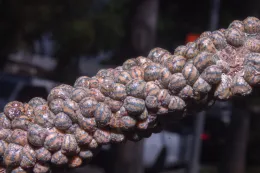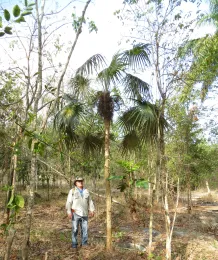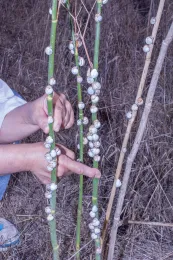2018 Articles:

The tuliptree scale (Toumeyella liriodendri) can be a serious and damaging pest of tuliptrees (Liriodendron tulipifera), magnolias (Magnolia spp.), and other members of the Magnoliaceae, and even some non-magnolia hosts. Its gregarious nature and heavy feeding remove plant sap, reduce plant vigor, cause shoot dieback and defoliation, distort growth, and can even lead to death. To add insult to injury, this pest produces copious amounts of honeydew, which promotes the growth of black sooty mold on leaves and stems, and coats portions of the tree and everything beneath its canopy in a severely annoying, sticky, dark to amber-colored, glossy, lacquer-like finish, making the tuliptree scale a particularly vile and nasty pest, especially in southern California on southern Magnolia (Magnolia grandiflora). Here we provide a summary of its history in southern California, signs and symptoms, identification and biology, hosts and distribution, and possible management strategies. DOI: https://doi.org/10.21414/B1DW23

Coccothrinax × angelae, the first natural hybrid described for this Caribbean palms genus, was considered until now a strict endemic of the Yaguanabo Valley, Cumanayagua municipality, Cienfuegos province, in the Trinidadense phytogeographic district in Central Cuba. As part of conservation activities carried out in Pitajones, Trinidad, Sancti Spíritus, Cuba to study the population of the threatened Coccothrinax crinita subsp. brevicrinis, scattered individuals of the hybrid Coccothrinax × angelae were discovered in two subpopulations surrounding Pitajones (SW and NE of the town). In May 2017, the hybrid was collected and specimens deposited in the Herbarium of the Botanical Garden of Sancti Spíritus, which document its first report and range extension for Sancti Spíritus and for the Heights of Sancti Spíritus of the Guamuhaya Massif, where it grows sympatrically with both parents, C. crinita subsp. brevicrinis and C. miraguama subsp. miraguama. DOI: https://doi.org/10.21414/B1959K

The white garden snail (Theba pisana), sometimes known as the Italian white snail, can be a serious pest of landscape ornamentals, including trees, shrubs, groundcovers, and herbaceous plants. Established in California for at least 100 years, it has mostly been inactive over this period although a few episodes of rather intense activity have occurred rather close to where it had originally established. In the last few years it has once again become more active in southern California. Here we provide a summary of its history in southern California, distribution and ecology, damage, identification and biology, and possible management strategies. DOI: https://doi.org/10.21414/B15C7N
